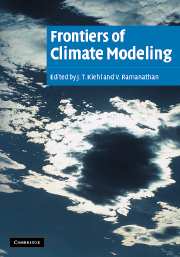Book contents
- Frontmatter
- Contents
- Preface
- List of Contributors
- Acknowledgments
- 1 Overview of climate modeling
- 2 Climate-change modeling: a brief history of the theory and recent twenty-first-century ensemble simulations
- 3 Energy-balance climate models
- 4 Intrinsic climatic variability: an essay on modes and mechanisms of oceanic and atmospheric fluid dynamics
- 5 The radiative forcing due to clouds and water vapor
- 6 A model study of the effect of Pinatubo volcanic aerosols on stratospheric temperatures
- 7 Unresolved issues in atmospheric solar absorption
- 8 Cloud feedbacks
- 9 Water-vapor feedback
- 10 Water-vapor observations
- 11 New frontiers in remote sensing of aerosols and their radiative forcing of climate
- 12 Cloud–climate feedback: lessons learned from two El Niño events
- 13 Runaway greenhouses and runaway glaciations: how stable is Earth's climate?
- Glossary
- Plate section
4 - Intrinsic climatic variability: an essay on modes and mechanisms of oceanic and atmospheric fluid dynamics
Published online by Cambridge University Press: 12 August 2009
- Frontmatter
- Contents
- Preface
- List of Contributors
- Acknowledgments
- 1 Overview of climate modeling
- 2 Climate-change modeling: a brief history of the theory and recent twenty-first-century ensemble simulations
- 3 Energy-balance climate models
- 4 Intrinsic climatic variability: an essay on modes and mechanisms of oceanic and atmospheric fluid dynamics
- 5 The radiative forcing due to clouds and water vapor
- 6 A model study of the effect of Pinatubo volcanic aerosols on stratospheric temperatures
- 7 Unresolved issues in atmospheric solar absorption
- 8 Cloud feedbacks
- 9 Water-vapor feedback
- 10 Water-vapor observations
- 11 New frontiers in remote sensing of aerosols and their radiative forcing of climate
- 12 Cloud–climate feedback: lessons learned from two El Niño events
- 13 Runaway greenhouses and runaway glaciations: how stable is Earth's climate?
- Glossary
- Plate section
Summary
Introduction
A folk adage is “the climate is what you expect; weather is what you get.” Taking a somewhat longer and more mechanistically explicit view, we might rephrase this as “the forced response is what you expect; intrinsic variability is what you get.”
Transient climatic forcing is defined, somewhat arbitrarily, as the external influences on Earth's climate involving astronomy, geology, evolution, and human activity: changes in the incident radiation from space; the shape of Earth's solid surface; the material composition of air, seawater, and the land surface; the species composition of biota; and anthropogenic land modification and pollutant emission. The other parts of the climatic system thus contribute to its internal dynamics in the atmosphere, ocean, land surface, and sea ice.
The climatic record evinces both forced and intrinsic variability. It is a reasonable view that the longer the time scale of fluctuation, the more likely that the forcing influence dominates. Yet some very simple climatic models – among those that are the subject of this chapter – show that natural variability can occur on all time scales, even well beyond the primary dynamical relaxation or adjustment times (e.g., weeks for the atmospheric troposphere or centuries for an abyssal oceanic basin). It is also a reasonable view that the global mean climate is more strongly influenced by external forcing, while the regional patterns are influenced at least as much if not more by intrinsic variability.
- Type
- Chapter
- Information
- Frontiers of Climate Modeling , pp. 73 - 118Publisher: Cambridge University PressPrint publication year: 2006
- 1
- Cited by

